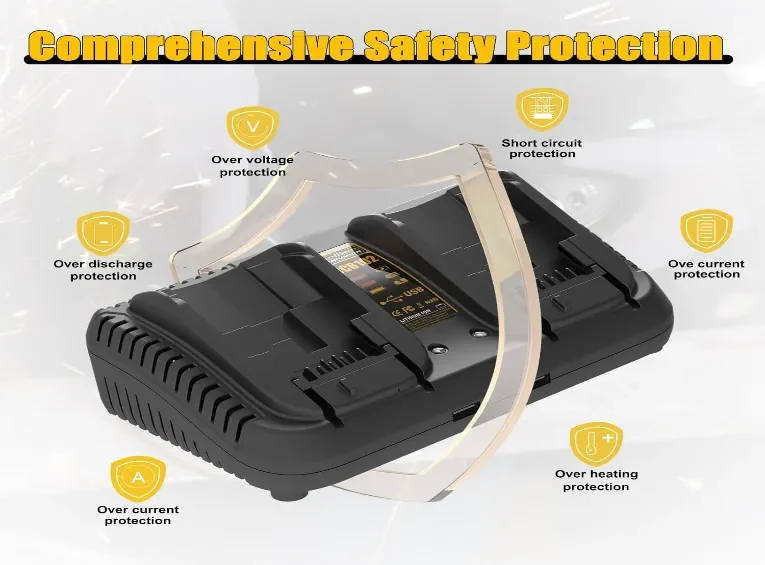How DeWalt Charger Handle High-Temperature Job Sites
High-temperature environments push chargers and Li-ion batteries to their limits. DeWalt chargers combine active thermal management with engineered protections to maintain safety and reliability. This guide explains thermal safeguards, operational best practices, early detection, and how to respond to heat events on site.

Why Heat Matters
-
Li-ion cells: high temperatures accelerate chemical reactions → faster capacity fade, swelling, risk of thermal runaway.
-
Charger electronics (SMPS, MOSFETs, capacitors) degrade faster → potential derating or failure.
-
Practical field thresholds:
| Temp Range | Meaning / Action |
|---|---|
| 5–40 °C (41–104 °F) | Safe operating range, normal charging |
| 40–45 °C (104–113 °F) | Caution: monitor packs and charger; improve airflow |
| >45–50 °C (113–122 °F) | Stop charge, isolate pack/charger; potential safety risk |
DeWalt Thermal Protections
-
Thermistors: monitor PCB & battery temperatures; throttle or stop charging if out-of-spec.
-
Thermal throttling / current derating: reduces charging current to limit heat build-up.
-
Hard cutout: full shutdown if critical temperature reached.
-
Per-bay isolation: one hot pack doesn’t affect others.
-
Soft-start & inrush limiting: protects internal components during repeated hot starts.
-
Fault LEDs: signal temperature wait or derate conditions.
-
Ventilation & heat spreaders: passive or active airflow keeps components cool.
Jobsite Placement & Engineering Controls
-
Shade & airflow: ventilated locations away from sun or exhaust heat.
-
Clearance: 10–15 cm around vents; avoid stacking chargers.
-
Elevate chargers: reduce heat from radiant surfaces.
-
Filtered enclosures: maintain airflow, prevent dust accumulation.
-
Dedicated circuits: short, heavy-gauge cords reduce voltage drop and heat.
Operational Workflows
-
Stagger charging cycles to prevent simultaneous heat peaks.
-
Prefer standard charging during heat waves; fast charge only if urgent.
-
Cooldown policy: rest packs 10–20 min before recharging.
-
Spare pack management: store shaded or in cooled areas.
-
Rotate chargers to balance wear across fleet.
Monitoring & Early Detection
| Tool / Method | Use | Threshold / Notes |
|---|---|---|
| IR thermometer | Check charger/pack surface temp | <40 °C OK, 40–45 °C monitor, >45 °C stop & isolate |
| LED signals | Temp-wait / derate indicators | Respond immediately; don’t force charge |
| Charge time logs | Detect throttling or component aging | Longer-than-normal cycles = potential thermal stress |
| Incident logs | Track repeated temp events | Plan preventive maintenance or retire stressed units |
Troubleshooting Heat Issues
-
Temp-wait/derate LED → move packs to cooler area, wait 15–30 min.
-
Pack surface >45 °C → stop charging, isolate outdoors, label/quarantine.
-
Swap-test suspect pack in cooled, known-good charger.
-
Charger overheating with good packs → retire/repair (likely aging capacitors or failed thermal paths).
-
Persistent or repeated events → escalate to manufacturer; retire frequent offenders.
Fleet Procurement & Spec Guidance
-
Specify chargers rated >40 °C for hot regions.
-
Require per-bay thermal derating and clear temp-fault LEDs.
-
Prefer robust ventilation and metal heat sinks.
-
Budget extra spares to rotate and reduce stress per pack.
Emergency Response & Safety
-
Smoke or flames → evacuate, call emergency services.
-
Hot or steaming packs → isolate outdoors, restrict access, contact recycler/manufacturer.
-
Document incidents: pack ID, charger ID, ambient temp, and actions taken.
Short FAQ
-
Shaded trailer without AC? Only if interior stays within spec; otherwise use ventilated outdoor stations.
-
Fast-charging in heat? Accelerates capacity fade; use sparingly.
-
How often to check temps? Spot-check during first 10 min; hourly for heavy-use shifts.
Conclusion
DeWalt chargers feature active thermal protections (thermistors, derating, cutouts), but site controls—shade, ventilation, staggered charging—and operational rules—cooldown, spare rotation—are essential. Any unit exceeding ~45 °C is a safety event and should be quarantined for inspection. Following these guidelines prolongs battery life, prevents downtime, and keeps crews safe.